![]()
![]()
![]()
Use LEFT and RIGHT arrow keys to navigate between flashcards;
Use UP and DOWN arrow keys to flip the card;
H to show hint;
A reads text to speech;
18 Cards in this Set
- Front
- Back
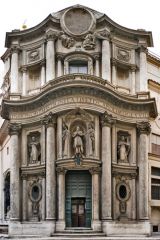
|
San Carlo alle Quattro Fontane
location: Rome architect: Francesco Borromini period: Baroque date: 1665-1676 Although Baroque buildings abound in Italy and eastern Europe, this is probably the best exemplar of Baroque architecture. The façade of the church undulates, with steps that invade the space of passing pedestrians. Inside, the church has great complexity, with oddly shaped chapels and side aisles all around. Most unique and intriguing, however, is the oval-shaped dome that floats, like the Hagia Sophia, over a base filled with windows. The coffering seems random at first, but actually has a discernable pattern and geometric consistency. To describe Baroque architecture, use terms like theatrical, plasticity, dynamic. |
|

|
) David
artist: Gianlorenzo Bernini period: Baroque date: 1623 Created for Cardinal Borghese, who held a mirror up to Bernini’s face so he could see his own expression of concentration and effort. The statue captures the very moment of decisive action, as the figure of David is moving through space and time to deliver the blow. We can see the energy twists up through David’s figure and is released as if part of a vortex – like a human tornado. |
|
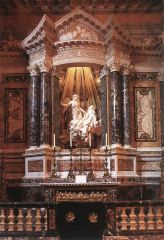
|
Cornaro Chapel
location: Rome artist: Bernini period: Baroque date: 1645-1652 Bernini conceived of the entire chapel, from the central statue of St. Teresa to the figures of the Cornaro family leaning out of their balcony seats as if to see the drama of St. Teresa’s epiphany. The ornamentation, the dramatic lighting on the central figure, the structure of the building itself are all in service of the dramatic and theatrical celebration of the sudden manifestation of faith that St. Teresa described in her visions. |
|
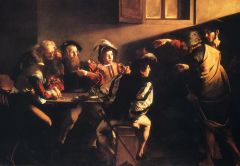
|
Calling of St. Matthew
artist: Caravaggio period: Baroque date: 1599-1600 This painting uses Caravaggio’s trademark lighting to dramatize the moment a tax collector was called to be one of the disciples. Levi – who will become St. Matthew, is pointing to himself as if to say, who me? The figure of Christ is barely noticeable as he stands in the shadows. The effect of a dramatic beam of light with the rest of the painting in shadow or darkness is called tenebrism. |
|
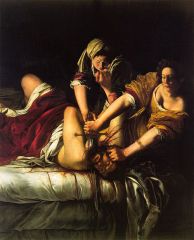
|
Judith Slaying Holofernes
artist: Artemesia Gentileschi period: Baroque date: 1614-1620 Artemesia was the first woman artist to be accepted into the Florentine Academy. She painted many versions of the story of Judith and Holofernes, perhaps because the cleverness and determination of Judith enables her to overcome the more powerful man. Artemesia definitely portrays Judith as more competent and physically able than male painters, such as her father and Caravaggio, did. The painting uses tenebrism – Artemesia’s father was a Caravaggisti. |
|
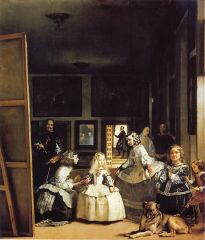
|
) Las Meninas
artist: Diego Velazquez period: Baroque date: 1656 The central figures in the painting are the king and queen, subtly included in the mirror as they look in on the scene of their daughter and her entourage. Velazquez has included himself in the painting, on a level or even slightly above the king, showing a certain kind of arrogant pride in the artist as equal to royalty because of his creative gifts. The technique – with Velazquez’ loose brushstrokes and suggestive blobs of paint – made this and other paintings by him much studied and loved by the impressionists. |
|
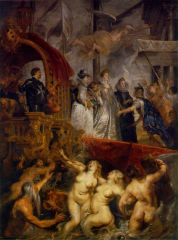
|
Arrival of Marie de’ Medici
artist: Peter Paul Rubens period: Baroque date: 1622-1625 Commissioned by Marie de Medici as propaganda to support her reign as regent for her young son after her husband, Henri IV was assassinated. Greeted by the allegorical figure of France, and surrounded by Neptune and the Nereids, as if the gods themselves are pleased Marie has come to France. Reinforces the idea of the divine right to rule. |
|
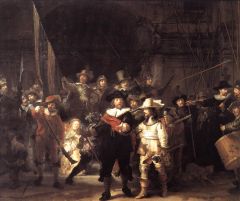
|
Capt. Frans Banning Cocq Mustering His Company
artist: Rembrandt van Rijn period: Baroque/Dutch Realism date: 1642 Commonly referred to as “Night Watch,” the painting depicts a militia group. Rembrandt has captured a moment of frenetic activity, high spirits, excitement. By using dramatic lighting, Rembrandt has highlighted each man’s face while making the two figures in the foreground the most prominent. They appear to be stepping out of the picture frame into our space. By using a kind of pyramidal composition, Rembrandt has given the painting depth – the shadows reach far into the background. The painting is an homage to the Dutch spirit of independence, freedom, community and transcends the goals of portraiture. |
|
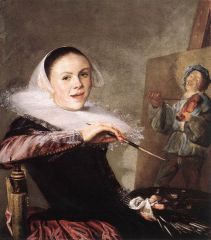
|
Self-Portrait
artist: Judith Leyster period: Baroque/Dutch Realism date: 1630 In this portrait, the artist has paused momentarily in her work to look back, as if the viewer has just entered the room, so once again the work has a theatrical quality. Her elegant dress and the fine chair in which she sits are symbols of her success as an artist whose popularity was based on the very type of painting under way on her easel. Her subject, a man playing a violin, may be a visual pun on the painter with palette and brush. So that the viewer would immediately see the difference between her painted portrait and the work on the easel, she varied her technique, executing the painted image more loosely. Clearly, this is an artist with considerable technical virtuosity. |
|
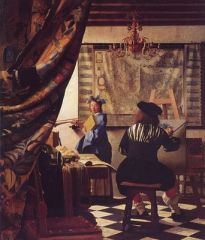
|
Allegory of the Art of Painting
artist: Jan Vermeer period: Baroque/Dutch Realism date: 1670-1675 This painting is an attempt to capture the nature of artistic inspiration, just as another allegorical painting, called the Allegory of Faith, attempts to capture the nature of faith. The artist’s model is a muse, and the map on the wall is a reminder of the act of discovery. The viewer, thanks to the curtain drawn back by an unseen hand, is placed in the role of voyeur. |
|
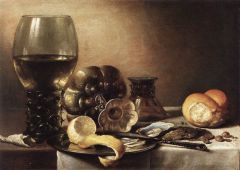
|
Still Life with Oysters, Rum Glass and Silver Cup
artist: Willem Claesz Heda period: Baroque/Dutch Realism date: unknown Like other Dutch still lifes, this painting has a dual purpose: to show off the wealth and prosperity of the owners but also to serve as a memento mori. The broken glass, half-peeled orange and tipped over goblet suggest someone has left the table hurriedly – a reminder of how transitory life is; how we can be snatched away in the “twinkling of an eye” as it says in the Bible. Note, too, that like other Dutch Baroque paintings, there is a great deal of interest in surface textures – the shine of the glass, the pebbly orange peel, the sheen on the oysters. |
|
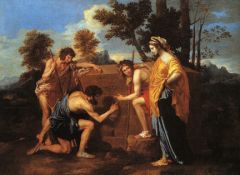
|
) Et in Arcadia Ego
artist: Nicolas Poussin period: Baroque date: 1655 Title translates as “I too once dwelt in Arcadia.” In Greek mythology, Arcadia is a pastoral landscape where everyone lives in harmony. The title is inscribed on the stone the shepherds are looking at; may be a message from one expelled from Arcadia or a reminder that even in Arcadia, man is mortal. Poussin codified the classical style which would dominate the Academy for the next 250 years. |
|
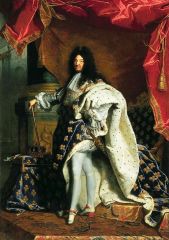
|
Louis XIV
artist: Hyacinthe Rigaud period: Baroque date: 1701 Louis XIV understood better than any other monarch how to consolidate power and radiate authority. He knew, for example, that pomp and circumstance cemented the illusion of power and we can see that theatrical flair in this portrait, which shows the king at the age of 63, at the height of his power. You can see how skillfully he has managed the stage set upon which his magnificence is displayed – he is framed by the massive ermine cloak, imprinted with the French fleur di lilys, as well as the red canopy above his head. Despite his small stature – he was only 5 foot 4 – Louis dominates the composition, with his arrogant pose and expression. |
|
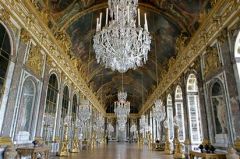
|
) Hall of Mirrors, Versailles
location: Versailles, France architects: Hardouin-Mansart & Le Brun period: Baroque date: 1680 Every nobleman was required to reside in Versailles – making it possible for Louis to control their every move. In previous centuries, the nobility had often challenged the sovereignty of the monarch; Louis made sure that they would not have the opportunity to do so ever again by removing them from their own seats of power, denying them private armies or even liveried servants, and turning over all of the daily running of the government to paid bureaucrats in his employ. The nobility were kept in a kind of golden bondage, convinced that their residence at Versailles was an honor – although it couldn’t have been too comfortable, given the dearth of bathrooms, the distance between the kitchen and the palace, and the very small rooms to which many of them were assigned. The public rooms, however, were a further expression of the King’s magnificence, the most famous of which was the Hall of Mirrors. This hall overlooks the park from the second floor and extends along most of the width of the central block. When it’s open, as it’s shown here, the mirrors reflect the light entering from outside and the whole has a gleaming quality to it – demonstrating once again the way Baroque artists and architects use light for emphasis and drama. |
|
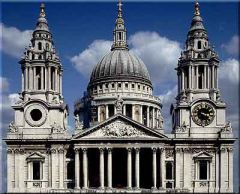
|
St. Paul’s Cathedral
location: London architect: Christopher Wren period: Baroque date; 1675-1710 When Cromwell died in 1658, England lapsed into war and in May 1660, the Parliament invited Charles II to return as King. The Restoration, as it was called, was highly successful, not least because Charles II was a popular and charismatic King. He had spent years in exile in Louis XIV’s court, yet he had the sense not to claim any of Louis’ absolute authority. He had a kind of live and let live philosophy, abetted by his love of luxury and pleasure. In terms of our study, the most momentous event in Charles II’s reign was the Great Fire of London, which took place in 1666. Most of the City of London – the heart of London which is now its financial district, comparable to Wall Street – burned to the ground. Charles II asked Christopher Wren to rebuild St. Paul’s Cathedral, London’s main church. Where a Gothic cathedral once stood, Wren, who was a mathematician and astronomer as well as an architect, erected St. Paul’s, a massive church which combined classical and Baroque elements. The effect Wren was going for was a façade that was much like Michelangelo had intended for St. Peter’s: a great dome centered between two towers. The lanterns of the towers, however, have the undulating plasticity of a Baroque façade, while the lower levels of the towers are Palladian, with their porticoed windows and engaged pilasters. The stacked temple fronts, with the paired columns and protruding porticoes resemble the Louvre façade. Despite these eclectic elements, the building is harmonious. |
|
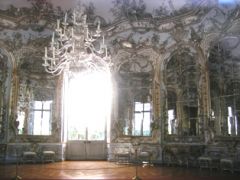
|
Amalienburg
location: Munich architect: Francois de Cuvillies period: Rococo date: early 18th century • a so-called “hunting lodge” in the park at Schloss Nymphemburg • lavishly decorated interior using expensive materials (silver ornamentation, Murano glass chandeliers, wallpaper and tiles imported from China) • exemplifies the delicate style of the Rococo with emphasis on light (direct from large windows and reflected in mirrors), pastel colors, elaborate decorations inspired by natural forms (rocaille = small pebbles or shells)/ |
|
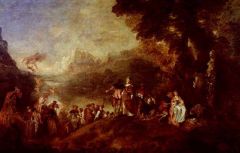
|
) Return from Cythera
artist: Watteau period: Rococo date: 1717-1719 • fetes galantes = well-dressed aristocrats conversing and dancing • idyllic landscape: island of eternal youth and love • if a leave-taking, tinged with melancholy |
|
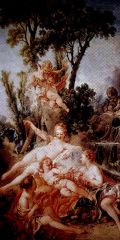
|
) Cupid a Captive
artist: Boucher period: Rococo date: 1754 • typical rococo: feathery brushstrokes, soft line, pastel colors • subject = pseudo mythology, usually featuring portrait of aristocratic patroness |

